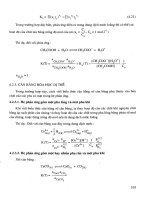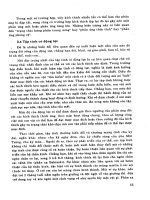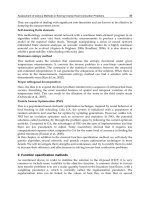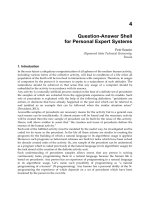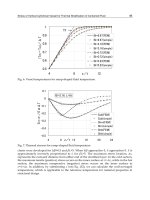Advanced Biomedical Engineering Part 3 docx
Bạn đang xem bản rút gọn của tài liệu. Xem và tải ngay bản đầy đủ của tài liệu tại đây (1.12 MB, 20 trang )
Pulse Wave Analysis
31
Arrhythmia is a common abnormal electrical activity in cardiovascular system. The heart
rate might go too fast or too slow which will cause the waveforms change shape among
continuous pulses. This feature can be captured in both time domain and frequency
domain. The basic feature in time domain is time variance among continuous pulses
exceeding the average level. The incomplete waveforms and merged waveforms often
result in the pulse detection fails which is also a sign of arrhythmia. Eight typical
arrhythmia waveforms have been identified from testing data and the patients do have
arrhythmia history on file.
Features from FFT are helpful to detect some disease or certain cardiac condition, but it’s
difficult to achieve high accuracy by frequency domain analysis only.
Wavelet transform is well known for localized variations of power analysis. It uses the time
and frequency domains together to describe the variability. Wavelet functions are localized
in space while Fourier sine and cosine functions are not.
Fig. 9. Wavelet transform for pulse wave with no diastolic component.
Fig. 10. Wavelet transform for pulse wave with clear diastolic component.
The algorithm can extract information from many kinds of data including audio and images
especially in geophysics fields. It has been used to analyze tropical convection (Weng 1994),
Advanced Biomedical Engineering
32
the El Niño–Southern Oscillation (Gu 1995), atmospheric cold fronts (Gamage 1993), central
England temperature (Baliunas 1997), the dispersion of ocean waves (Meyers 1993), wave
growth and breaking (Liu 1994), and coherent structures in turbulent flows (Farge 1992).
Wavelet provides multi-resolution analysis to the source data that make the result more
adequate for feature detection.
Fig. 9. and Fig. 10 show the difference between pulse wave with diastolic component and
pulse wave without diastolic component. Diastolic component can be easily detected by
value variance among adjacent points. It has significant impact on slope changes of
continuous values. It also generates additional peak values at Wavelet transform result.
2.2.2 Waveform similarity
Since pulse data is two dimensional time serial data, the mining techniques for time serial
data can be applied on it. The waveforms can be categorized based on the similarity
between testing waveform and well classified sample waveforms. Because the waveforms
have same structure: taller systolic component with lower diastolic component following,
the similarity calculation can achieve high accuracy. It can be measured by the total distance
of corresponding points between sample waveform and testing waveform warping.
Fig. 11. Demonstration for waveform difference comparison
One of the most fundamental concepts in the nonlinear pattern recognition is that of 'time-
warping' a reference to an input pattern so as to register the two patterns in time. The DTW
proposed by Sakoe and Chiba (1971) is one of the most versatile algorithms in speech
recognition. Figure shows the basic idea about the time warping.
Pulse Wave Analysis
33
The majority application for DTW was speak recognition in the early research period. (Sakoe
1978) It achieve higher recognition rate with lower cost than most other algorithms. Medical
data has been analyzed with DTW recently. ECG is one of the most common signals in
health care environment, so most researches focus on ECG signal analysis.
DTW was applied to ECG segmentation first since segmenting the ECG automatically is the
foundation for abnormal conduction detection and all analysis tasks. DTW based single lead
method achieve smaller mean error with higher standard deviation than two-lead Laguna’s
method. (Vullings 1998)
DTW
A sample waveform is denoted as {x
i
(j) , I ≤j ≤J}, and an unknown frame of the signal as {x(i),
I ≤ i ≤ I). The purpose of the time warping is to provide a mapping between the time indices
i and j such that a time registration between the waveforms is obtained. We denote the
mapping by a sequence of points c = (i,j), between i and j as (Sakoe and Chiba 1978)
=
{
(
)
,1≤≤
}
(6)
where c(k) = (i(k), j(k)) and { x(i), 1≤i≤I } is testing data, { x
t
(j), 1≤ j ≤ J } is the template data.
Warping function finds the minimal distance between two sets of data:
(
)
=
(
)
,
(
)
=
(
)
−
(
)
(7)
The smaller the value of d, the higher the similarity between x(i) and x
t
(j)
The optimal path minimize the accumulated distance D
T
=
min
{M}
∑
dc
(
k
)
w
(
k
)
(8)
Where
w
(
k
)
is a non-negative weighting coefficient.
To find the optimal path, we use
(
)
=
(
)
+min
(
−1
)
(9)
Where
(
)
represents the minimal accumulated distance
There’s two restrictions for warping pulse wave
1.
Monotonic Condition: i(k-1) ≤ i(k) and j(k-1 ≤j(k)
2.
Continuity condition : i(k) – i(k-1) ≤ 1 and j(k) – j(k-1) ≤ 1
The symmetric DW equation with slope of 1 is
Dc
(
k
)
=dc
(
k
)
+min
(
−1
)
,
(
−2
)
+2(
(
)
,
(
−1
)
)
(
−1
)
,
(
−1
)
+2(
(
)
)
(
−2
)
,
(
−1
)
+2(
(
−1
)
,
(
)
)
(10)
The optimal accumulated distance is normalized by (I+J) for symmetric form.
To implement this algorithm, I designed three classes: TimeSeriesPoint, TimeSeries, and
DTW. TimeSeriesPoint can hold an array of double values which means the algorithm can
process signals from multiple sensors or leads. The number of signals is defined as the
dimensions of the time series data. The get function will return the value for a specific signal
based on the input dimension. There are also some utility methods to return the data array,
hash the value, or check the equivalence to other TimeSeriesPoint.
Advanced Biomedical Engineering
34
TimeSeries is a collection of TimeSeriesPoints. A list of labels and a list of time reading are
provided for the time series data to mark the time and special points. Label and time
reading can be retrieved for each point by the method getLabel(int n) and
getTimeAtNthPoint(int n). The size of the TimeSeries is the number of TimeSeriesPoints
stored in the data structure. Method getMeasurement(int pointIndex, int valueIndex) is
provided to find the value of specific signal at the given time point.
Fig. 12. Pulse wave form from a patient with acute anterior myocardial infarction
The above pulse wave was taken from a male patient at department of cardiology. He had a
history of myocardial infarction for 8 years and came to the clinic again for angina pectoris.
His cardiac function was rated as NYHA level IV and had to sleep in bed.
The waveform is a typical one with poor cardiac function. The systolic part is very sharp
and narrow that suggests very low Cardiac Output. The diastolic component is lost since the
weak pulse. Blood vessel condition is not measurable because the cardiac function is in an
accurate stage.
The characteristics of this pulse wave can be summarized as following:
-
Low pulse pressure
-
Low cardiac output
-
At least half of the waveform is around the base line
-
Sharp and narrow systolic component
-
No diastolic component
Fig. 1. Pulse wave for patient with Old myocardial infarction and degenerative valvular
disease
Pulse Wave Analysis
35
The above pulse wave is collected from a patient with old myocardial infarction
and degenerative valvular disease. He has chest distress and ictal thoracalgia for eighteen
years. Gasping happened for the recent 6 months and the pain increased in intensity
for the last 3 months. The patient also has mitral regurgitation and tricuspid regurgitation
that make him difficult to finish some daily activities. His cardiac function is rated
NYHA IV.
The waveform has regular shape with diastolic component. The systolic part becomes
broader than usual which might because of the compensatory blood supply after
myocardial infarction. The waveform has multiple peak values after systolic top should be
the result of old myocardial infarction and degenerative valvular disease.
With review of similar waveforms and medical history, waveforms in this category have
-
The waveforms have a broader systolic component
-
The diastolic component could have different shape depends on the arteries condition.
-
The cardiac output usually has normal values.
Fig. 2. Pulse wave for a patient with Ventricular aneurysm
This pulse wave belongs to a 57 years old male patient. Coronary angiography shows that
arteriostenosis at left anterior descending artery reduce 40% - 50% of the artery’s capacity.
The first diagonal branch and leftcircumflex also have arteriostenosis. Ventricular aneurysm
occupies 30% chambers of the heart.
The systolic part of waveform doesn’t have very clear features. The diastolic component
goes vertical direction longer than normal waveform. A little uplift could be observed at the
end of diastolic component.
There are eight patients with Ventricular aneurysm in the pulse database and 6 of them have
pulse wave belong to this category.
-
Major significance in diastolic part, give more weight when calculating distance
-
Having extra step to check the end of diastolic component will help to identify the
waveform
A fifteen years old male patient took the pulse wave test after admission in hospital. He had
palpitation for eight years and had oliguresis, edema of lower extremity for recent 3 months.
He had fast heart rate which could reach 140/min. The heart border expanded to left and
the pulse was weak. Cardiac ultrasonic shows that left ventricle had spherical expansion.
The interventricular septum and ventricular wall were thin. The cardiac output and cardiac
index decreased.
Advanced Biomedical Engineering
36
This class of waveform is characterized by separated systolic component and diastolic
component. The pulse pressure decreased to a very low lever before the diastolic component
and the diastolic part is relatively bigger.
Fig. 3. Pulse wave for Dilated cardiomyopathy
3. Pulse wave monitoring system
Analysis techniques have strength on different areas. Pulse wave factors have good
detection rate for cardiovascular risks. Waveform analysis is more suitable for over all
evaluation and cardiovascular health classification. The combination of both strategies is the
model proposed in this thesis.
The monitoring system is designed to adapt this model. Single test data can provide
some hints of subject’s health condition. If showing the history data of the subject together,
the trend line of the health condition is much more valuable for subject’s treatment.
Considering the similar pulse data with medical records gives additional support for
decision making.
The system includes four modules to handle the data acquisition, transfer and local storage.
The four modules are (Figure): Electrocardiogram Sensor, Pulse Oximeter Sensor, Non
Invasive Blood Pressure Sensor, a computer or mobile device collecting vital signs and
transmitted to Control Center.
Since patients have various risk at different time periods, whole day model will be
established during the training period. Usually some measurements are significantly lower
at night such as systolic blood pressure, diastolic blood pressure, pulse rate etc. The system
will create different criteria for risk detection based on training data. This solution gives
continuous improvements at server side for both individual health condition analysis and
overall research on pulse wave.
Control Center accepts two types of data: real time monitoring data and offline monitoring
data. Real time monitoring aims at detecting serious heart condition in a timely manner.
Real time data are bytes (value ranged from 0 – 255) transferred in binary format in order to
reduce bandwidth consuming. The standard sampling rate is 200 points per second and can
be reduced to 100 or 50 points per second based on the performance of the computer or
portable device. Once the connection is initialized, device will send data every second which
means up to 200 bytes per channel. The maximum capacity of real time data package
Pulse Wave Analysis
37
contains 3-lead ECG and 1 pulse wave data. A modern server can easily handle more than
one hundred connections with high quality service at the same time.
Fig. 4. Remote Monitoring System using pulse oximeter, ECG, and Blood pressure
Control Center has Distributed Structure to improve the Quality of Service. The Gateway is
responsible for load balance and server management. It accepts connection requests and
forwards them to different servers. Local server will receive high priority for the
connections which means servers are likely to serve local users first. Those servers which
can work individually, will process the messages in detail. We can easily maintain servers in
the system and problem with one server will not affect the system in this way. Servers will
select typical and abnormal monitoring data with the statistic logs (monitoring time,
maximum, minimum, average of monitoring values, etc) and upload back to data center for
future references. Data center has ability to trace the usage of specific user based on the
routing records.
The abnormal ECG or Pulse Wave forms will be detected at server side. Actions might be
taken after the data is reviewed by medical professionals. Control center will contact the
relatives or emergency department in some predefined situations.
Offline data will be generated at client side regarding to the usage. It also includes the
typical and abnormal monitoring data with the statistic logs. The system provides a web
based application for user to manage monitoring records. Users can easily find out their
health condition among specific time period with the help of system assessment. Doctors’
advice may add to the system when review is done.
Research verifies that the medical data is more valuable if they can be analyzed together.
Data transfer and present layers follows the Electronic Health Record standard. The
monitoring network not only backup data, analyze them in different scales, but also provide
the pulse data on the cloud to convenience users accessing their pulse records anytime from
home, clinic and other places.
Advanced Biomedical Engineering
38
4. References
Alan, S.; Ulgen, MS.; Ozturk, O.; Alan, B.; Ozdemir, L. & Toprak, N. (2003). Relation
between coronary artery disease, risk factors and intima-media thickness of carotid
artery, arterial distensibility, and stiffness index. Angiology 2003;54:261-267.
Baliunas, S., P. Frick, D. Sokoloff, and W. Soon, 1997: Time scales and trends in the central
England temperature data (1659–1990): A wavelet analysis. Geophys. Res. Lett., 24,
1351–54.
Bates, B. (1995) A Guide to Physical Examination, 6th edition, J.B. Lippingcott Company,
Philadelphia, USA.
Berton, C. & Cholley, B. (2002). Equipment review: New techniques for cardiac output
measurement – oesophageal Doppler, Fick principle using carbon dioxide, and
pulse contour analysis. Critical Care 2002, 6:216–221
Cain, ME.; Ambos, D.; Witkowski, FX. & Sobel, BE. (1984). Fast-Fourier transform analysis of
signal-averaged electrocardiograms for identification of patients prone to sustained
ventricular tachycardia, Circulation 69 (1984), pp. 711–720.
Cholley, BP.; Shroff, SG.; Sandelski, J.; Korcarz, C.; Balasia, BA.; Jain, S.; Berger, DS.;
Murphy, MB.; Marcus, RH. & Lang, RM. (1995). Differential effects of chronic oral
antihypertensive therapies on systemic arterial circulation and ventricular
energetics in African-American patients. Circulation. 1995;91:1052–1062.
Cohn, JN.; Finkelstein, SM.; McVeigh, GE. et al. Noninvasive pulse wave analysis for the
early detection of vascular disease. Hypertension 1995;26:503–8.
Dar, O.; Riley, J.; Chapman, C.; Dubrey, SW.; Morris, S.; Rosen, SD.; Roughton, M. & Cowie,
MR. (2009). A randomized trial of home telemonitoring in a typical elderly heart
failure population in North West London: results of the Home-HF study. Eur J
Heart Fail. 2009 Mar;11(3):319–325
Eguchi, K.; Kuruvilla, S.; Ogedegbe, G.; Gerin, W.; Schwartz, JE. & Pickering, TG. (2009).
What is the optimal interval between successive home blood pressure readings
using an automated oscillometric device? Journal of Hypertension, 27, 1172-1177.
Erlanger, J. & Hooker, D. R. (1904). Johns Hopk. Hosp. Rep. 12, 357.
Farge, M., 1992: Wavelet transforms and their applications to turbulence. Annu. Rev. Fluid
Mech., 24, 395–457.
Felbinger, TW.; Reuter, DA.; Eltzschig, HK.; Bayerlein, J. & Goetz, AE. (2005). Cardiac index
measurements during rapid preload changes: a comparison of pulmonary artery
thermodilution with arterial pulse contour analysis. J Clin Anesth 2005;17:241-8
Gamage, N., and W. Blumen, 1993: Comparative analysis of lowlevel cold fronts: Wavelet,
Fourier, and empirical orthogonal function decompositions. Mon. Wea. Rev., 121,
2867–2878.
Green, JF. (1984) Mechanical Concepts in Cardiovascular and Pulmonary Physiology. Lea &
Febiger, Philadelphia, Pennsylvania, USA.
Gu, D., and S. G. H. Philander, 1995: Secular changes of annual and interannual variability
in the Tropics during the past century. J. Climate, 8, 864–876.
Hast, J. (2003) “Self-mixing interferometry and its applications in non invasive pulse
detection,” Ph.D. dissertation, Department of Electrical and Information
Engineering, University of Oulu, Finland, 2003.
Pulse Wave Analysis
39
Huang, B. & Kinsmer, W. (2002) “ECG frame classification using Dynamic Time Warping,”
Proc. IEEE Canadian Conference on Electrical & Computer Engineering, 2002.
Kangasniemi, K. & Opas, H. (1997). Suomalainen lääkärikeskus 1. Toinen painos. WSOY,
Porvoo (In Finnish).
Langewouters, G J.; Wesseling, KH. & Goedhard, W J A (1984) The static elastic properties
of 45 human thoracic and 20 abdominal aortas in vitro and the parameters of a new
model. Journal of Biomechanics 17: 425–435.
Liu, P. C., 1994: Wavelet spectrum analysis and ocean windwaves. Wavelets in Geophysics,
E. Foufoula-Georgiou and P. Kumar, Eds., Academic Press, 151–166.
Mahomed, F. A. (1872). The physiological and clinical use of the sphygmograph. Medical
Times Gazette 1, 62—64.
Mahomed, F. A. (1874). The aetiology of bright’s disease and the prealbuminuric stage. Med
Chir Trans 57:197-228
Mahomed, F. A. (1877). On the sphygmographic evidence of arterio-capillary fibrosis. Trans
Path Soc 28:394-397
Meyers, S. D., B. G. Kelly, and J. J. O’Brien, 1993: An introduction to wavelet analysis in
oceanography and meteorology: With application to the dispersion of Yanai waves.
Mon. Wea. Rev., 121, 2858–2866.
O’Rourke, MF & Mancia, G. (1999) Arterial stiffness. J Hypertens. 1999;17:1–4.
O’Rourke, M.; Pauca, A. & Jiang, X-J. (2001) Pulse wave analysis. Br J Clin Pharmacol. 2001;
51: 507–522.
Persell, SD.; Dunne, AP.; Lloyd-Jones, DM. & Baker, DW. (2009) Electronic health record-
based cardiac risk assessment and identification of unmet preventive needs. Med
Care 47:418–424, 2009
Postel-Vinay, MC. (1996) Growth hormone- and prolactin-binding proteins: soluble forms of
receptors. Horm Res 45:178–181
Rödig, G.; Prasser, C.; Keyl, C.; Liebold, A. & Hobbhahn, J. (1999). Continuous cardiac
output measurement: pulse contour analysis vs thermodilution technique in
cardiac surgical patients. Br J Anaesth 1999; 82: 525–30
Sakoe, H. & Chiba, S. (1978). Dynamic Programming Optimization for Spoken Word
Recongition, IEEE Transactions on Signal Processing, Vol. 26, pp 43- 49.
Spencker, S.; Coban, N.; Koch, L.; Schirdewan, A. & Muller, D. (2009). Potential role of home
monitoring to reduce inappropriate shocks in implantable cardioverter-defibrillator
patients due to lead failure. Europace 2009;11:483-8.
Timothy, SM.; Barbara, ES; Joseph, L. & Izzo, Jr (2002) Validity and Reliability of Diastolic
Pulse Contour Analysis (Windkessel Model) in Humans. Hypertension 2002;
39:963-8
Vullings, H.; Verhaegen, M. & Verbruggen, H. (1998) “Automated ECG segmentation with
dynamic time warping,” in Proc. 20th Ann. Int. Conf. IEEE Engineering in
Medicine and Biology Soc., Hong Kong, 1998, pp. 163–166.
Weng, H., and K M. Lau, 1994: Wavelets, period doubling, and time-frequency localization
with application to organization of convection over the tropical western Pacific. J.
Atmos. Sci., 51, 2523–2541.
Advanced Biomedical Engineering
40
Zhang, G.; Kong, X. & Liao, S. (2008). “Pulse wave analysis for cardiovascular information
monitoring in patients with chronic heart failure: effects of COQ10 treatment”
Montreal: Bio-engineering 2008
0
Multivariate Models and Algorithms for Learning
Correlation Structures from Replicated Molecular
Profiling Data
Lipi R. Acharya
1
and Dongxiao Zhu
1,2
1
University of New Orleans, New Orleans
2
Research Institute for Children, Children’s Hospital, New Orleans
U.S.A.
1. Introduction
Advances in high-throughput data acquisition technologies, e.g. microarray and
next-generation sequencing, have resulted in the production of a myriad amount of molecular
profiling data. Consequently, there has been an increasing interest in the development of
computational methods to uncover gene association patterns underlying such data, e.g. gene
clustering (Medvedovic & Sivaganesan, 2002; Medvedovic et al., 2004), inference of gene
association networks (Altay and Emmert-Streib, 2010; Butte & Kohane, 2000; Zhu et al., 2005),
sample classification (Yeung & Bumgarner, 2005) and detection of differentially expressed
genes (Sartor et al., 2006). However, outcome of any bioinformatics analysis is directly
influenced by the quality of molecular profiling data, which are often contaminated with
excessive noise. Replication is a frequently used strategy to account for the noise introduced
at various stages of a biomedical experiment and to achieve a reliable discovery of the
underlying biomolecular activities.
Particularly, estimation of the correlation structure of a gene set arises naturally in many
pattern analyses of replicated molecular profiling data. In both supervised and unsupervised
learning, performance of various data analysis methods, e.g. linear and quadratic
discriminate analysis (Hastie et al., 2009), correlation-based hierarchial clustering (Eisen et al.,
1998; de Hoon et al., 2004; Yeung et al., 2003) and co-expression networking (Basso et al., 2005;
Boscolo et al., 2008) relies on an accurate estimate of the true correlation structure.
The existing MLE (maximum likelihood estimate) based approaches to the estimation of
correlation structure do not automatically accommodate replicated measurements. Often, an
ad hoc step of data preprocessing by averaging (either weighted, unweighted or something
in between) is used to reduce the multivariate structure of replicated data into bivariate
one (Hughes et al., 2000; Yao et al., 2008; Yeung et al., 2003). Averaging is not completely
satisfactory as it creates a strong bias while reducing the variance among replicates with
diverse magnitudes. Moreover, averaging may lead to a significant amount of information
loss, e.g. it may wipe out important patterns of small magnitudes or cancel out opposite
patterns of similar magnitudes. Thus, it is necessary to design multivariate correlation
estimators by treating each replicate exclusively as a random variable. In general, the
experimental design that specifies replication mechanism of a gene set may be unknown
3
2 Will-be-set-by-IN-TECH
(blind) or known (informed) to data analysts. The suite of multivariate models and algorithms
offer flexible ways to capture the correlation structure of a gene set with diverse replication
mechanisms and allow for further generalizations.
In this chapter, we present bivariate and multivariate approaches to estimate the correlation
structure of a gene set with replicated measurements. We begin with two popular bivariate
correlation estimators, Pearson’s correlation (Eisen et al., 1998; Kung et al., 2005) and
SD-weighted correlation (Hughes et al., 2000; Yeung et al., 2003) followed by a comprehensive
discussion of three generalized multivariate models, blind-case model, informed-case model
and finite mixture model introduced in (Acharya & Zhu, 2009; Zhu et al., 2007; 2010) to
estimate the correlation structure of a gene set with either blind or informed replication
mechanism. We analyze the performance of various correlation estimators using synthetic
and real-world replicated data sets.
2. Replicated molecular profiling data
Molecular profiling data in the present context refers to a numerical matrix of gene abundance
levels, where rows correspond to genes and columns represent experiments (samples).
High-throughput platforms, such as microarrays, enable the scientists to simultaneously
interrogate the expression abundance of tens of thousands of genes in the living cell. A
microarray experiment is typically performed by hybridizing target cRNA samples labeled
with fluorescent dyes on a glass slide spotted with oligonucleotides. After hybridization,
the glass slide is washed and scanned to detect the gene expression levels. Some of the
popular microarray platforms include Affymetrix GeneChip, Agilent Microarray, Illumina
BeadArray and housemade twocolor arrays. Based on the experimental design employed by
a data acquisition platform, the replication mechanism underlying molecular profiling data
can be either blind or informed to data analysts (Figure 1). For example, the measurements
from Affymetrix GeneChip platform (Lokhart et al., 1996) correspond to blind replication
mechanism, where expression levels of a gene are measured by designing a set of 11
perfect match sibling probes against the 3-prime end of mRNA, although a mixture of gene
isoforms can exist. On the other hand, some of the more recent Illumina hybridization-based
BeadArray (Gunderson et al., 2004) and deep sequencing based Genome Analyzer II
(Shendure & Ji, 2008) platforms utilize an informed replication mechanism. Indeed, such
platforms simultaneously profile 6
− 12 samples of whole-genome gene expression in a
chip, where both biological and technical replicates can be used in the experiment. Many
studies also use a more general replication strategy of combining the two mechanisms, e.g.
blind replication mechanism nested within the informed mechanism and vice versa (Kerr &
Churchill, 2001). It is necessary to explicitly consider both blind and informed mechanisms
for a robust pattern analyses of replicated data. For instance, Fig. 1 presents two gene sets
with the same number of replicated measurements, however, their underlying correlation
structures differ by incorporating the prior knowledge of replication mechanism. For a
comprehensive correlation based analysis of replicated molecular profiling data with both
blind and informed replication mechanism, we refer to (Zhu et al., 2010).
3. Bivariate correlation estimators
In this section, we discuss two bivariate correlation estimators, Pearson’s correlation (Eisen
et al., 1998; Kung et al., 2005; Rengarajan et al., 2005) and SD-weighted correlation (Hughes
42
Advanced Biomedical Engineering
Multivariate Models and Algorithms for Learning Correlation Structures from Replicated Molecular Profiling Data 3
5101520
0246
Sample Index
G
ene Expression
5101520
051015
Sample Index
G
ene Expression
Fig. 1. Correlation structures (left) and molecular profiling data (right) corresponding to a
pair of genes, each with 4 replicated measurements. The upper panels represent the
correlation structure and molecular profiling data with blind replication mechanism,
whereas the lower panels correspond to the ones with informed replication mechanism. In
case of informed replication mechanism 2 biological replicate and 2 technical replicates
nested within each biological replicates are used for a gene.
43
Multivariate Models and Algorithms for
Learning Correlation Structures from Replicated Molecular Profiling Data
4 Will-be-set-by-IN-TECH
et al., 2000; van’t Veer et al., 2002; Yeung et al., 2003), frequently used in the analysis of
replicated molecular profiling data. We assume that the abundance levels of two genes X
and Y with m
1
and m
2
replicated measurements respectively, are simultaneously measured
over n independent experiments. If x
ij
and y
ij
denote the abundance levels of X and Y in the
i
th
replicate and j
th
sample respectively, we write
¯
x
j
=
1
m
1
m
1
∑
i=1
x
ij
(1)
and
¯
y
j
=
1
m
2
m
2
∑
i=1
y
ij
(2)
for the average measurements in the j
th
sample,
¯
x
=
1
n
n
∑
j=1
¯
x
j
(3)
and
¯
y
=
1
n
n
∑
j=1
¯
y
j
(4)
for the grand means of the measurements,
s
2
x
(j)=
1
m
1
− 1
m
1
∑
i=1
(x
ij
−
¯
x
j
)
2
(5)
and
s
2
y
(j)=
1
m
2
− 1
m
2
∑
i=1
(y
ij
−
¯
y
j
)
2
(6)
for the variances in the j
th
sample,
¯
x
w
=
n
∑
j=1
¯
x
j
s
2
x
(j)
/
n
∑
j=1
1
s
2
x
(j)
(7)
and
¯
y
w
=
n
∑
j=1
¯
y
j
s
2
y
(j)
/
n
∑
j=1
1
s
2
y
(j)
, (8)
for the SD-weighted average measurements corresponding to X and Y, j
= 1, . . . , n.
3.1 Pearson’s correlation estimator
Pearson’s correlation coefficient is a well-known similarity measure for clustering molecular
profiling data (Eisen et al., 1998). The estimate of correlation between X and Y is defined
in terms of unweighted average of replicated measurements for a gene across different
experiments (Kung et al., 2005; Rengarajan et al., 2005) and is given by
cor
(X, Y)=
∑
n
j
=1
(
¯
x
j
−
¯
x
)(
¯
y
j
−
¯
y
)
∑
n
j
=1
(
¯
x
j
−
¯
x
)
2
∑
n
j
=1
(
¯
y
j
−
¯
y
)
2
. (9)
44
Advanced Biomedical Engineering
Multivariate Models and Algorithms for Learning Correlation Structures from Replicated Molecular Profiling Data 5
In case of a gene set with k genes X
1
, ,X
k
, where m
i
replicated measurements are available
for X
i
, the correlation structure is defined by all pairwise correlations cor(X
i
, X
j
), i, j =
1, . . . , k. Due to its closed-form representation, Pearson’s estimator enjoys computational
simplicity. However, it is exclusively based on estimating bivariate correlation from a data
with multivariate structure. Additionally, the estimator assigns equal weights to all replicates
of a gene without considering the variation in their magnitudes, which is often large for data
generated from high-throughput platforms. To overcome this problem, a number of more
generalized correlation estimators have been proposed by considering weighted average of
replicated measurements in place of simple average.
3.2 SD-weighted correlation estimator
The SD-weighted correlation estimator considers weighted average of replicated
measurements, where weights are determined by standard deviations of the measurements
across different experiments. The SD-weighted correlation between X and Y is defined as
(Hughes et al., 2000; Zhu et al., 2010)
cor
w
(X, Y)=
∑
n
j
=1
¯
x
j
−
¯
x
w
s
x
(j)
¯
y
j
−
¯
y
w
s
y
(j)
∑
n
j
=1
¯
x
j
−
¯
x
w
s
x
(j)
2
∑
n
j
=1
¯
y
j
−
¯
y
w
s
y
(j)
2
. (10)
Advantages of SD-weighted correlation have been demonstrated in terms of increased
accuracy and stability in cluster analysis, compared with Pearson’s estimator (Yeung et al.,
2003). Nevertheless, SD-weighted estimator also does not explicitly accommodate replicated
measurements and requires a preprocessing of data by computing their weighted average. In
averaging, many useful patterns of small magnitude may be wiped out or patterns of opposite
magnitude may be canceled out. Moreover, standard deviation of replicated measurements
may not be a faithful representation of their internal variation, specially when the number
of replicates is small. This problem has been addressed by considering a shrinkage version of
the correlation estimator (Yao et al., 2008), however, none of the aforementioned estimators are
ready to explicitly accommodate replicated data and exploit prior knowledge of experimental
design that explains replication mechanism.
4. Multivariate correlation estimators
In this section, we review three multivariate models, blind-case model (Acharya & Zhu,
2009; Zhu et al., 2007), informed-case model (Zhu et al., 2010) and finite mixture model
(Acharya & Zhu, 2009) for estimating the correlation structure from replicated measurements
corresponding to a gene set with blind or informed replication mechanism. Throughout this
section, we treat each replicated measurement individually as a random variable and assume
that data are independently and identically distributed samples from a multivariate normal
distribution. We discuss the parameter structures for each model and their estimation from
replicated measurements corresponding to a pair of genes X and Y or a gene set with k
genes X
1
, ,X
k
. It is assumed that gene abundance levels are measured over n independent
samples, where m
i
replicated measurements of the i
th
gene X
i
are available in each of them,
i
= 1, . . . , k. We denote the n multivariate samples by Z
j
, j = 1, . . . , n.
45
Multivariate Models and Algorithms for
Learning Correlation Structures from Replicated Molecular Profiling Data
6 Will-be-set-by-IN-TECH
4.1 Blind-case model
Blind-case model from (Acharya & Zhu, 2009; Zhu et al., 2007) estimates the correlation
structure of a gene set with replicated measurements by assuming a constrained set of
parameters in the multivariate normal distribution. The model is designated as ‘blind’ since it
imposes a fixed number of within-molecular and between-molecular correlation parameters
in the underlying correlation structure. Throughout this section, we follow the notations from
(Acharya & Zhu, 2009). The parameters, mean vector μ
B
and the correlation matrix Σ
B
, for
the blind-case model are defined as
μ
B
=
⎡
⎢
⎣
μ
B
x
1
e
m
1
.
.
.
μ
B
x
k
e
m
k
⎤
⎥
⎦
(11)
where μ
B
x
i
is a scalar and e
m
i
=(1, ,1)
T
is a vector of size m
i
× 1, for i = 1, ,k. The
correlation matrix Σ
B
of size
∑
k
i
=1
m
i
×
∑
k
i
=1
m
i
has the following structure
Σ
B
=
⎡
⎢
⎢
⎢
⎢
⎢
⎢
⎢
⎢
⎢
⎢
⎢
⎢
⎣
1 ρ
11
ρ
1k
ρ
1k
.
.
.
.
.
.
.
.
.
.
.
.
.
.
.
.
.
.
ρ
11
1 ρ
1k
ρ
1k
.
.
.
.
.
.
.
.
.
.
.
.
.
.
.
.
.
.
ρ
k1
ρ
k1
1 ρ
kk
.
.
.
.
.
.
.
.
.
.
.
.
.
.
.
.
.
.
ρ
k1
ρ
k1
ρ
kk
1
⎤
⎥
⎥
⎥
⎥
⎥
⎥
⎥
⎥
⎥
⎥
⎥
⎥
⎦
=
⎡
⎢
⎢
⎣
Σ
B
11
Σ
B
1k
.
.
.
.
.
.
.
.
.
Σ
B
1k
T
Σ
B
kk
⎤
⎥
⎥
⎦
, (12)
where Σ
B
ij
is a m
i
× m
j
submatrix defined in terms of a single parameter ρ
ij
. The parameters
ρ
ij
’s correspond to either within-molecular correlation (case i = j) or between-molecular
correlation (case i
= j). As a correlation matrix is symmetric, it is assumed that ρ
ij
=
ρ
ji
. For practical purposes, only between-molecular correlations are of interest, whereas
within-molecular correlations indicate data quality. Indeed, higher values of within-molecular
correlations correspond to cleaner data.
To estimate the model parameters, the path of maximum likelihood estimation is followed.
Due to their asymptotic properties, the MLE’s are frequently used in parameter estimation
problems when the underlying distribution is multivariate normal (Casella & Berger, 1990).
Suppose the n observations Z
j
’s are sampled from multivariate normal distribution N(μ, Σ)
with parameters μ and Σ, where n >
∑
k
i
=1
m
i
. Then the likelihood function is defined as
L
(μ, Σ)=
n
∏
j=1
N(Z
j
|μ, Σ)=
1
(2π)
1
2
(
∑
k
i
=1
m
i
)n
|Σ|
1
2
n
exp[−
1
2
n
∑
j=1
(Z
j
− μ)
T
Σ
−1
(Z
j
− μ)]. (13)
46
Advanced Biomedical Engineering
Multivariate Models and Algorithms for Learning Correlation Structures from Replicated Molecular Profiling Data 7
The MLE’s are estimated by maximizing L with respect to μ and Σ. In the present context,
if the the abundance level of l
th
gene in its i
th
replicate and j
th
sample is denoted by x
l
ij
, the
MLE’s of μ
B
and Σ
B
are obtained by solving
d
L/dμ
B
x
l
= 0, (14)
for l
= 1, ,k and
d
L/dΣ = 0, (15)
where
L = log L. This results in
ˆ
μ
B
x
l
=
1
n
1
m
l
n
∑
j=1
m
l
∑
i=1
x
l
ij
(16)
for l
= 1, ,k. Thus, the MLE of μ
B
is
ˆ
μ
B
=
⎡
⎢
⎣
ˆ
μ
B
x
1
e
m
1
.
.
.
ˆ
μ
B
k
e
m
k
⎤
⎥
⎦
. (17)
The MLE of Σ
B
is given by
ˆ
Σ
B
=
1
n
n
∑
j=1
(Z
j
−
ˆ
μ
B
)(Z
j
−
ˆ
μ
B
)
T
. (18)
As the parameters
ˆ
ρ
ij
’s may not be tractable in practice, they are estimated using
ˆ
ρ
ij
= Avg(
ˆ
Σ
B
ij
), i, j = 1, ,k. (19)
Equations 17-19 are used to obtain the correlation structure from blind-case model. When k
=
2, blind-case model is defined in terms of two within-molecular and one between molecular
correlation parameters, as presented in (Zhu et al., 2007). Further, if there are no replicates for
X and Y or m
1
= m
2
= 1, blind-case model and Pearson’s correlation coefficient (Eq. 9) are
connected as follows (Zhu et al., 2007)
ˆ
ρ
12
=
n − 1
n
cor
(X, Y). (20)
Overall, blind-case model presents a simple and parsimonious multivariate approach for
estimating the correlation structure of a gene set with blind replication mechanism. As the
MLE’s of parameters have closed-form representation, the model is computationally very
efficient, e.g. it is well known that the infinite Bayesian mixture model approach (Medvedovic
& Sivaganesan, 2002; Medvedovic et al., 2004) suffers from non-trivial computational
complexity as the number of genes and replicated measurements increases. However,
blind-case model always imposes a fixed number of parameters in the model. This may
correspond to an oversimplified representation of the underlying correlation structure of a
gene set or an overly constrained correlation structure in case of replicated data for which
the underlying experimental design is known. Thus, it is desirable to consider more flexible
47
Multivariate Models and Algorithms for
Learning Correlation Structures from Replicated Molecular Profiling Data
8 Will-be-set-by-IN-TECH
multivariate models by explicitly incorporating prior knowledge of replication mechanisms
in the correlation structure.
4.2 Informed-case model
Informed-case model introduced in (Zhu et al., 2010) generalizes blind-case model by
accommodating prior knowledge of replication mechanism. In many cases the number of
biological and technical replicates used in the experimental design are known. Informed-case
model utilizes this information and assigns different parameters for the biological replicates
of a gene. For simplicity, we present the informed-case model for two genes X and Y, where 3
biological replicates and 2 technical replicates nested within each biological replicate are used
for each of them. This representation can be naturally extended to the case of a gene set with
a given number of biological and technical replicates. Throughout this section, we follow the
notations from (Zhu et al., 2010). The two parameters, mean vector μ
I
and correlation matrix
Σ
I
, for the informed-case model are defined as
μ
I
=
μ
1
x
, μ
1
x
, μ
2
x
, μ
2
x
, μ
3
x
, μ
3
x
, μ
1
y
, μ
1
y
, μ
2
y
, μ
2
y
, μ
3
y
, μ
3
y
T
(21)
and
Σ
I
=
⎛
⎜
⎜
⎜
⎜
⎜
⎜
⎜
⎜
⎜
⎜
⎜
⎜
⎜
⎜
⎜
⎜
⎜
⎜
⎜
⎜
⎜
⎝
1 ρ
tt
ρ
12
x
ρ
12
x
ρ
13
x
ρ
13
x
ρ
11
xy
ρ
11
xy
ρ
12
xy
ρ
12
xy
ρ
13
xy
ρ
13
xy
ρ
tt
1 ρ
12
x
ρ
12
x
ρ
13
x
ρ
13
x
ρ
11
xy
ρ
11
xy
ρ
12
xy
ρ
12
xy
ρ
13
xy
ρ
13
xy
ρ
21
x
ρ
21
x
1 ρ
tt
ρ
23
x
ρ
23
x
ρ
21
xy
ρ
21
xy
ρ
22
xy
ρ
22
xy
ρ
23
xy
ρ
23
xy
ρ
21
x
ρ
21
x
ρ
tt
1 ρ
23
x
ρ
23
x
ρ
21
xy
ρ
21
xy
ρ
22
xy
ρ
22
xy
ρ
23
xy
ρ
23
xy
ρ
31
x
ρ
31
x
ρ
32
x
ρ
32
x
1 ρ
tt
ρ
31
xy
ρ
31
xy
ρ
32
xy
ρ
32
xy
ρ
33
xy
ρ
33
xy
ρ
31
x
ρ
31
x
ρ
32
x
ρ
32
x
ρ
tt
1 ρ
31
xy
ρ
31
xy
ρ
32
xy
ρ
32
xy
ρ
33
xy
ρ
33
xy
ρ
11
xy
ρ
11
xy
ρ
21
xy
ρ
21
xy
ρ
31
xy
ρ
31
xy
1 ρ
tt
ρ
12
y
ρ
12
y
ρ
13
y
ρ
12
y
ρ
11
xy
ρ
11
xy
ρ
21
xy
ρ
21
xy
ρ
31
xy
ρ
31
xy
ρ
tt
1 ρ
12
y
ρ
12
y
ρ
13
y
ρ
12
y
ρ
12
xy
ρ
12
xy
ρ
22
xy
ρ
22
xy
ρ
32
xy
ρ
32
xy
ρ
21
y
ρ
21
y
1 ρ
tt
ρ
23
y
ρ
23
y
ρ
12
xy
ρ
12
xy
ρ
22
xy
ρ
22
xy
ρ
32
xy
ρ
32
xy
ρ
21
y
ρ
21
y
ρ
tt
1 ρ
23
y
ρ
23
y
ρ
13
xy
ρ
13
xy
ρ
23
xy
ρ
23
xy
ρ
33
xy
ρ
33
xy
ρ
31
y
ρ
31
y
ρ
32
y
ρ
32
y
1 ρ
tt
ρ
13
xy
ρ
13
xy
ρ
23
xy
ρ
23
xy
ρ
33
xy
ρ
33
xy
ρ
31
y
ρ
31
y
ρ
32
y
ρ
32
y
ρ
tt
1
⎞
⎟
⎟
⎟
⎟
⎟
⎟
⎟
⎟
⎟
⎟
⎟
⎟
⎟
⎟
⎟
⎟
⎟
⎟
⎟
⎟
⎟
⎠
, (22)
where ρ
ij
x
, ρ
ij
y
and ρ
ij
xy
denote within-molecular and between-molecular correlations between
i
th
and j
th
biological replicates. As the technical replicates of a biological replicate are often
highly correlated, we use a single parameter ρ
tt
to represent their correlation.
Analogous to the case of blind-case model (Eq. 14 and Eq. 15), the MLE’s
ˆ
μ
I
and
ˆ
Σ
I
are given
by the following sets of equations
ˆ
μ
j
m
1
x
=
1
I
j
m
1
n
n
∑
k=1
∑
j
l
=1
I
l
m
1
∑
i=
∑
j
l
=1
I
l−1
m
1
+1
x
ik
,1≤ j
m
1
≤ J
m
1
(23)
ˆ
μ
j
m
2
y
=
1
I
j
m
2
n
n
∑
k=1
∑
j
l
=1
I
l
m
2
∑
i=
∑
j
l
=1
I
l−1
m
2
+1
y
ik
,1≤ j
m
2
≤ J
m
2
(24)
48
Advanced Biomedical Engineering
Multivariate Models and Algorithms for Learning Correlation Structures from Replicated Molecular Profiling Data 9
ˆ
μ
I
=
ˆ
μ
1
x
, ,
ˆ
μ
1
x
, ,
ˆ
μ
J
m
1
x
, ,
ˆ
μ
J
m
1
x
,
ˆ
μ
1
y
, ,
ˆ
μ
1
y
, ,
ˆ
μ
J
m
2
y
, ,
ˆ
μ
J
m
2
y
T
(25)
and
ˆ
Σ
I
=
1
n
n
∑
j=1
(Z
j
−
ˆ
μ
I
)(Z
j
−
ˆ
μ
I
)
T
. (26)
Here, J
m
1
, J
m
2
denote the number of biological replicates for X and Y, whereas I
j
m
1
, I
j
m
2
,1≤
j
m
1
≤ J
m
1
,1≤ j
m
2
≤ J
m
2
, represent the number of technical replicates nested within j
th
m
1
and
j
th
m
2
biological replicate respectively, where
∑
J
m
1
j=1
I
j
m
1
= m
1
and
∑
J
m
2
j=1
I
j
m
2
= m
2
. However, on
averaging the off-diagonal block of
ˆ
Σ
I
to estimate a single correlation value, as in the case
of blind-case model (Eq. 19), between-molecular correlations from informed-case model and
blind-case model become identical (see (Zhu et al., 2010) for proof). To exploit the informed
replication mechanism and compare model performances, likelihood ratio test based methods
(Anderson, 1958) are used. Indeed, the hypothesis
H
0
: Z ∈ N(μ, Σ
0
) versus H
α
: Z ∈ N(μ, Σ)
is tested by considering (μ, Σ)=(μ
B
, Σ
B
) and (μ, Σ)=(μ
I
, Σ
I
). Matrix Σ
0
is obtained by
setting the off-diagonal entries in Σ to 0. Likelihood ratio test statistics for blind-case and
informed-case models are calculated using
Ψ
= −2 log(∧) (27)
where
∧ =
|
ˆ
Σ
0
|
−n/2
exp(
−1
2
∑
n
j
=1
(Z
j
−
ˆ
μ
)
T
ˆ
Σ
−1
0
(Z
j
−
ˆ
μ
))
|
ˆ
Σ
|
−n/2
exp(
−1
2
∑
n
j
=1
(Z
j
−
ˆ
μ
)
T
ˆ
Σ
−1
(Z
j
−
ˆ
μ
))
. (28)
Under null hypothesis, the two statistics Ψ
B
= −2 log ∧
B
and Ψ
I
= −2 log ∧
I
corresponding
to blind-case and informed-case model follow an asymptomatic chi-square distribution with
1 and J
m
1
J
m
2
degrees of freedom, respectively. Thus, the model performances can be
evaluated by comparing the P-values
(P) from blind-case and informed-case models or
directly comparing the difference Ψ
I
− Ψ
B
to the chi-square distribution with J
m
1
J
m
2
− 1
degrees of freedom. For a more detailed study on informed-case model, we refer to (Zhu
et al., 2010).
It is clear that informed-case correlation estimator generalizes blind-case model by explicitly
considering prior knowledge of experimental design. When there is only one biological
replicate for each gene in replicated data, the two models become identical. Although
informed-case model is useful, it is not practical to design a correlation structure that
will fit for any replicated molecular profiling data. A key is to adaptively determine the
underlying correlation structure by balancing between a model with a constrained set of
parameters and the one without any constraints. This situation can be translated into the
Expectation-Maximization (EM) framework (Dempster et al., 1977), where we seek for the
missing membership of a multivariate observation in either a component with a constrained
set of parameters or the one with an unconstrained set of parameters. EM algorithm plays a
crucial role in the following generalization of blind-case or informed-case model.
49
Multivariate Models and Algorithms for
Learning Correlation Structures from Replicated Molecular Profiling Data
10 Will-be-set-by-IN-TECH
4.3 Finite mixture model
In the finite mixture model approach (Fraley & Raftery, 2002; McLachlan & Peer, 2000), density
of an observation is modeled as mixture of a finite number of component densities. Such an
approach can be used to shrink the correlation structure of a gene set between a constrained
correlation structure and an unconstrained one. Advantages of shrinkage approach have
been demonstrated in many related studies (Schäfer & Strimmer, 2005; Zhu & Hero, 2007).
In the following discussion, we consider the two-component mixture model approach from
(Acharya & Zhu, 2009), where the density of each multivariate observation Z
j
is modeled as a
mixture of two component densities denote by f
1
(Z
j
) and f
2
(Z
j
). This is expressed as
f
(Z
j
, Ψ)=π
1
f
1
(Z
j
)+π
2
f
2
(Z
j
), (29)
where π
1
and π
2
stand for mixture proportions with π
1
+ π
2
= 1 and Ψ denotes the set of all
parameters in the mixture model, j
= 1, ,n. The first component in the mixture represents
either blind-case or informed-case estimator, whereas the second component corresponds
to the unconstrained
∑
k
i
=1
m
i
-variate multivariate normal distribution. Let θ
i
= {μ
i
, Σ
i
}
denote the set of parameters for the i
th
component, i = 1, 2, where θ
1
= {μ
B
, Σ
B
} or
θ
1
= {μ
I
, Σ
I
}. Finite mixture model employs EM algorithm (McLachlan & Peer, 2000) to
estimate the posterior probability that the j
th
observation belongs to the i
th
component of
the mixture. Thus, incompleteness in the EM framework is incorporated by considering
the component-indicator vectors z
j
’s, j = 1,2, . . . , n, where (z
j
)
i
= z
ij
= 1ifZ
j
is sampled
from the i
th
component, as unobserved. Complete data is comprised of the observations Z
j
’s
together with the component-indicator vectors z
j
’s. The E step and M step at the (k + 1)
th
iteration are defined as
E-step: For i
= 1, 2,
τ
i
(Z
j
; Ψ
(k)
)=
π
(k)
i
f
i
(Z
j
; θ
(k)
i
)
∑
2
h
=1
π
(k)
h
f
h
(Z
j
; θ
(k)
h
)
(30)
where τ
i
(Z
j
; Ψ
(k)
) is the posterior probability that Z
j
belongs to the i
th
component.
M-step: For i
= 1, 2,
π
k+1
i
=
1
n
n
∑
j=1
τ
i
(Zj; Ψ
(k)
) (31)
μ
k+1
i
=
∑
n
j
=1
τ
(k)
ij
Z
j
∑
n
j
=1
τ
(k)
ij
(32)
Σ
k+1
i
=
∑
n
j
=1
τ
(k)
ij
(Z
j
− μ
(k+1)
i
)(Z
j
− μ
(k+1)
i
)
T
∑
n
j
=1
τ
(k)
ij
(33)
where τ
(k)
ij
= τ
i
(Z
j
; Ψ
(k)
). EM algorithm iterates between the E step and the M step until
convergence. Finally, an observation Z
j
corresponds to a component model for which it
has higher posterior probability of belonging, j
= 1, 2, . . . , n. However, in many cases the
sequence
{log L(Ψ
k
)} of log-likelihood values generated in the iterative procedure may not
be bounded or it may be trapped in a local solution (McLachlan & Peer, 2000). Consequently,
50
Advanced Biomedical Engineering
